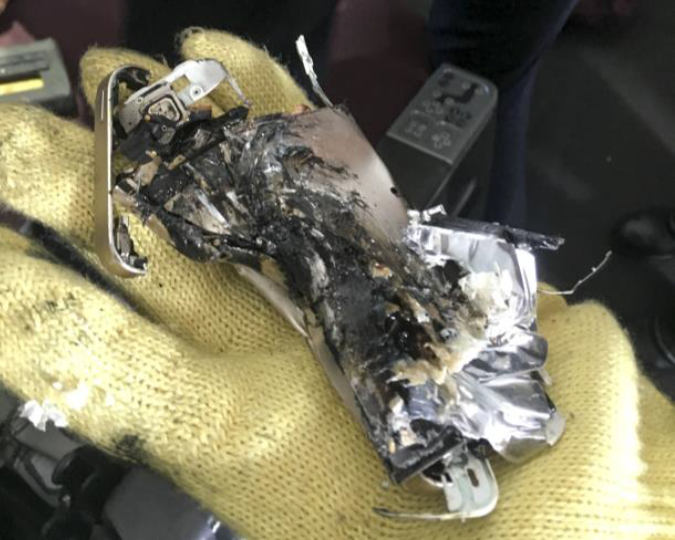What happened
On 15 May 2016, a Qantas Airways Airbus A380 aircraft, registered VH-OQD, operated flight QF7 from Sydney, New South Wales to Dallas-Fort Worth, Texas, United States.
About two hours prior to the aircraft’s arrival in Dallas-Fort Worth, a passenger alerted the cabin crew to the presence of smoke in the cabin. The cabin crew then initiated the basic fire drill procedure.
Two of the cabin crew proceeded to the source of the smoke with fire extinguishers. At the same time, the customer services manager (CSM) made an all stations emergency call on the aircraft interphone to alert flight crew and other cabin crew to the presence of smoke.
The cabin crew located the source of the smoke at seat 19F, in Zone F, on the upper deck (Figure 1). The crew removed the seat cushions and covers from seat 19F while the CSM turned off the power to the centre column of the seats. When the seat was further dismantled, the crew found a crushed personal electronic device (PED) wedged tightly in the seat mechanism. The cabin crew assessed that the crushed PED contained a lithium battery.
Figure 1: Cabin diagram showing the seat from where the smoke emanated

Source: Qantas, modified by ATSB
By that time, the PED was no longer emitting smoke, however, a strong acrid smell remained in the cabin. The crew then manoeuvred the seat and freed the PED (Figure 2). The crew placed the PED in a jug of water, which was then put in a metal box and monitored for the remainder of the flight.
The flight crew did not receive any abnormal indications or warnings.
No passengers were injured, and the aircraft was not damaged in the incident.
Figure 2: Crushed PED after removal from seat

Source: Qantas
Operator comments
The aircraft operator commented that it has been estimated over one billion lithium batteries are transported by air every year, with potentially hundreds carried on single sectors on large aircraft. As such, both cabin crew and passenger education remains a key component to managing these events. Raising passenger awareness of the potential hazards of PEDs commences at check-in, through to the pre-flight safety demonstration, and aims to minimise the risk of PED thermal runaway events.
Qantas Airlines’ basic fire drill is based on a teamwork approach, with the division of duties between three central crew and as many supporting crew as available and required. This division of duties allocates the responsibilities of fighting the fire, retrieving equipment and ensuring lines of communication with the flight deck remain uninterrupted.
ATSB comment
Similar occurrences
The ATSB has received 17 notifications of similar incidents of lithium battery thermal events in aircraft over the past 6 years.
The ATSB investigation AO-2014-082 details an example where a short circuit between lithium batteries initiated a fire in an aircraft cargo hold.
Safety message
This incident provides an excellent example of an effective response to an emergency situation. The crew were able to quickly implement the basic fire drill procedure which defined the roles and responsibilities of the responding crew. This enabled a rapid and coordinated response to the smoke event using all available resources. The effective implementation of this procedure also ensured the flight crew were kept informed as the situation developed.
This incident also highlights the hazards of transporting lithium-ion battery powered PEDs. The Civil Aviation Safety Authority web page Travelling safely with batteries and pamphlet Is your luggage safe? provide information on the safe carriage of lithium-ion batteries and lithium-ion powered devices aboard aircraft.
Aviation Short Investigations Bulletin - Issue 50
Purpose of safety investigationsThe objective of a safety investigation is to enhance transport safety. This is done through:
It is not a function of the ATSB to apportion blame or provide a means for determining liability. At the same time, an investigation report must include factual material of sufficient weight to support the analysis and findings. At all times the ATSB endeavours to balance the use of material that could imply adverse comment with the need to properly explain what happened, and why, in a fair and unbiased manner. The ATSB does not investigate for the purpose of taking administrative, regulatory or criminal action. TerminologyAn explanation of terminology used in ATSB investigation reports is available here. This includes terms such as occurrence, contributing factor, other factor that increased risk, and safety issue. Publishing informationReleased in accordance with section 25 of the Transport Safety Investigation Act 2003 Published by: Australian Transport Safety Bureau © Commonwealth of Australia 2016
Ownership of intellectual property rights in this publication Unless otherwise noted, copyright (and any other intellectual property rights, if any) in this report publication is owned by the Commonwealth of Australia. Creative Commons licence With the exception of the Coat of Arms, ATSB logo, and photos and graphics in which a third party holds copyright, this publication is licensed under a Creative Commons Attribution 3.0 Australia licence. Creative Commons Attribution 3.0 Australia Licence is a standard form licence agreement that allows you to copy, distribute, transmit and adapt this publication provided that you attribute the work. The ATSB’s preference is that you attribute this publication (and any material sourced from it) using the following wording: Source: Australian Transport Safety Bureau Copyright in material obtained from other agencies, private individuals or organisations, belongs to those agencies, individuals or organisations. Where you wish to use their material, you will need to contact them directly. |


